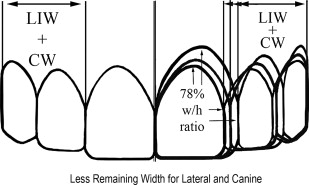Proportional smile design is a useful tool for evaluating and designing smiles that are in harmony with the face. Although not always observed in nature, the recurring esthetic dental proportion is preferred by dentists surveyed to the width proportions observed in nature with normal-length teeth. The width/length ratio of the central incisor is a key determinant in providing a smile that is pleasing to dentists. Using the desired tooth length while maintaining the preferred 78% width/length ratio of the central incisor in conjunction with the recommended recurring esthetic dental proportion is a good method for designing a smile balanced with the face.
Key points
- •
Proportional smile design can be used to design a smile in harmony with the face. A smile created with the 78% width/length ratio of the maxillary central incisor has been shown to be preferred by dentists surveyed.
- •
Keeping the relative lengths of the teeth consistent with the height of the patient is recommended.
- •
A method of determining the relative widths of the maxillary anterior teeth should be used.
- •
Producing an imaged view of the recommended smile before active treatment is important to allow discussion and input from the patient to achieve pleasing results.
Introduction
Dentists and laboratory technicians have an important role in creating pleasing smiles for their patients. Methods that can predictably satisfy the patient should be used. Studies have measured the sizes and key proportions of the natural teeth. Most people have variations in their smile that deviate from the published standards for ideal smiles. Orthodontic treatment is performed on a significant population of patients who are not satisfied with what nature has given them in their smiles. People spend significant amounts of money with plastic surgeons and dermatologists to look different than what was their natural appearance. Do we as dentists always want to give patients a smile that mirrors what is often found in nature, such as crowded, overlapped, and twisted teeth, malocclusions or diastemas ( Figs. 1 and 2 )? Do we want to design smiles so they mimic the sizes and proportions found in nature? Should the use of proportions that are preferred by dentists be considered in addition to the proportions observed in nature?
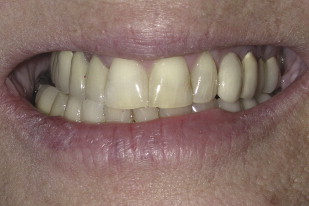
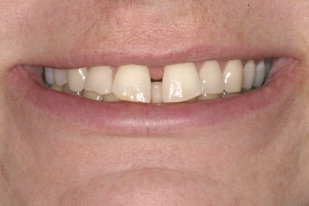
Introduction
Dentists and laboratory technicians have an important role in creating pleasing smiles for their patients. Methods that can predictably satisfy the patient should be used. Studies have measured the sizes and key proportions of the natural teeth. Most people have variations in their smile that deviate from the published standards for ideal smiles. Orthodontic treatment is performed on a significant population of patients who are not satisfied with what nature has given them in their smiles. People spend significant amounts of money with plastic surgeons and dermatologists to look different than what was their natural appearance. Do we as dentists always want to give patients a smile that mirrors what is often found in nature, such as crowded, overlapped, and twisted teeth, malocclusions or diastemas ( Figs. 1 and 2 )? Do we want to design smiles so they mimic the sizes and proportions found in nature? Should the use of proportions that are preferred by dentists be considered in addition to the proportions observed in nature?
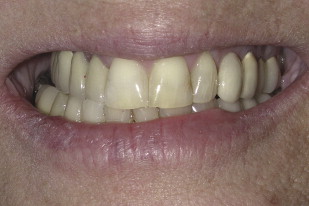
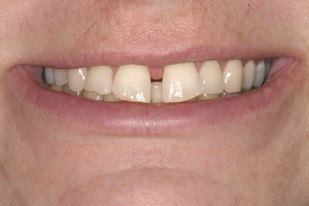
The golden proportion
The golden proportion has been considered the standard by many for determining the ideal widths of the anterior teeth. Based on formulas defined by ancient Greek mathematicians, the proportion has developed mythical connotations ( Fig. 3 ). Although often cited as the reference for designing smiles it has been this author’s observance that smiles supposedly designed by this method were not conformant with this practice. When the proportions of natural anterior teeth were evaluated in numerous studies, the golden proportion was not found to be the predominant proportion observed.
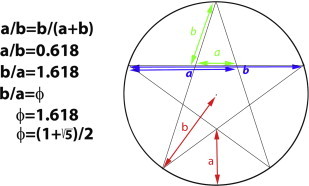
Natural proportions
Studies have been conducted worldwide to determine the proportions of the teeth. Results vary according to location. Preston observed that the average frontal tooth to tooth width proportion of North American dental students was 66% for the lateral incisor/central incisor and 84% for the canine/lateral incisor. Forster and colleagues reported that the average tooth to tooth width proportion of patients evaluated at a faculty of dentistry in Hungary was 62% for the lateral incisor/central incisor and 85% for the canine/lateral incisor. Asians often report lateral incisors that are smaller than their North American and European counterparts. When reviewing articles to understand the natural proportions that exist, it is important to consider the ethnicity and region in which the study was performed to determine their applicability when designing smiles in other areas of the world.
The average width/length (w/l) ratio of the maxillary central incisor has been reported in one well-known study to be 85% to 86%. Another study reports the mean w/l ratio of the central incisor to be 90%. The w/l ratio can be influenced by several factors. Most studies evaluate the visible display of the length of the central incisor, not the distance from the incisal edge to the cementoenamel junction. Altered passive eruption in young patients who are often evaluated in studies would result in a higher reported observed w/l ratio than if the entire clinical crown were exposed. As a patient ages, there can be incisal wear that also increases the w/l ratio. Age variations can be a significant factor affecting the w/l ratio values reported. Fig. 4 is an imaged photograph of a natural proportion smile with the Preston width proportion (66%, 84%) and the 86% w/l ratio of the central incisor.
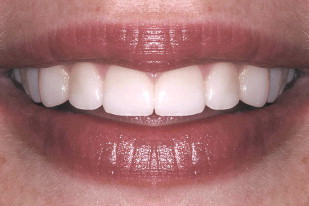
Recurring esthetic dental proportion
The recurring esthetic dental (RED) proportion has been proposed as a model in designing smiles. The RED proportion states that the proportion of the successive widths of the teeth as viewed from the front should remain constant as one moves distally ( Fig. 5 ). The frontal view width of every maxillary tooth becomes smaller by a certain percentage as one moves posteriorly. This is a two-dimensional evaluation of a three-dimensional smile, so the buccal/palatal placement of the teeth affects their apparent widths. The range of suggested RED proportions is between 62% and 80%. The golden proportion (62% RED proportion) is applicable as one of many proportions that fit within the definition of the RED proportion. Different RED proportions can be proposed for use with the same individual according to the desired length of the teeth, the scope of treatment possible, and the desire to have the size of the teeth match the size of the face and body ( Fig. 6 ). The expanded definition of the RED proportion includes using the relative tooth height and body height to determine the appropriate RED proportion.
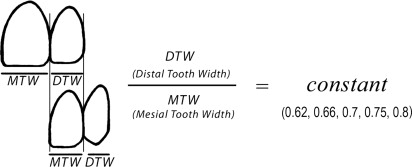

Preferred proportions versus natural proportions
A study comparing different RED proportions with different heights of teeth found dentists surveyed preferred a resulting smile that kept the w/l ratio of the resulting central incisor in the 75% to 78% range. Dentists surveyed preferred people with tall teeth to have a wider central incisor to maintain the preferred 75% to 78% w/l ratio. This is different than the 85% to 86% w/l ratio, which has been reported as what is observed in natural teeth ( Fig. 7 ). Another study comparing different proposed and natural tooth to tooth width proportions found that a slight majority of dentists surveyed preferred the 70% RED proportion to the Preston proportion with normal-length teeth. Most dentists surveyed preferred proportions that are not coincident with natural proportions. This asks the question whether naturally occurring proportions should always be used when patient elective treatment is sought. Fig. 8 is an imaged photograph of a smile with the 70% RED proportion and the 78% w/l ratio of the central incisor.
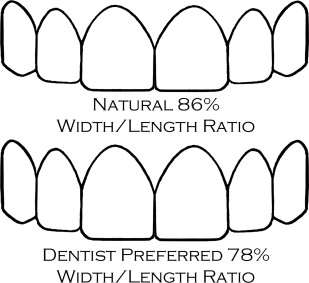
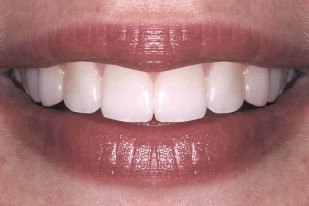
Affect of central incisor height on central incisor width and appropriate recurring esthetic dental proportion
Because the preferred maxillary central incisors of tall teeth are also wider they occupy a greater percentage of the smile leaving less space for the remaining anterior teeth ( Fig. 9 ). The width of the lateral incisors and canines must be a smaller percentage of the central incisor resulting in a smaller RED proportion being preferred. The smaller the RED proportion, the more dominant is the central incisor. Smiles designed using the golden proportion (62% RED) exhibit prominent central incisors, which together occupy 50% of the intercanine width (ICW). This seems logical when one considers that tall models tend to look more attractive with smiles designed with the 62% RED (golden) proportion. Conversely, dentists preferred people with short teeth to have more narrow central incisors to maintain the preferred 75% to 78% w/l ratio. Because the central incisors do not occupy as much space there is more room for the remaining anterior teeth and the lateral incisors and canines are more similar in width resulting in a larger RED proportion ( Fig. 10 ). The percentage difference is not as great as one moves distally, resulting in a RED proportion closer to 80%.

